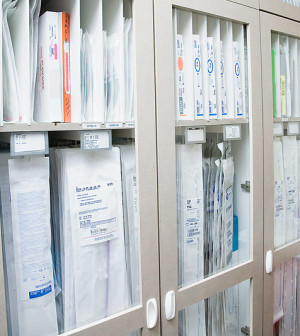- See What Saffron Can Do for Sleep and Heart Health
- 6 Common Mistakes to Avoid Before Your Physical
- Can Sweating Really Help You Beat a Cold?
- Strengthening Your Relationship: Practical Strategies
- Skip Storing This Everyday Product in the Fridge Door
- Green Tea + B3 Pairing May Boost Brain Health
- Navigating Your Midlife Crisis: Embracing New Possibilities
- City Raccoons Showing Signs of Domestication
- Mapping the Exposome: Science Broadens Focus to Environmental Disease Triggers
- One Week Less on Social Media Linked to Better Mental Health
Home Births May Be Safe for ‘Low-Risk’ Pregnancies: Study

Some babies born at home seem to fare as well as similar babies born in a hospital, a new Canadian study finds.
However, the researchers only looked at pregnancies considered to be low risk, and emergency services did have to respond to about 8 percent of the home births, the study found.
A leading critic of home births dismissed the findings, and said that midwives are more integrated into the health system in Canada than in the United States.
But study author Eileen Hutton, director of the Midwifery Education Program at McMaster University in Hamilton, Ontario, said the results should be comforting to pregnant women considering whether to give birth at home.
“I’d feel very reassured that the outcomes for home birth are good,” she said. But she added that women giving birth at home must take special precautions in case of an emergency.
“As long as there’s coordination between home and hospital, you could say home birth appears to be as safe as giving birth at the hospital,” Hutton said.
There is a small, but growing, trend toward birth at home in the United States. As of 2009, less than 1 percent of births occurred at home, but that number — 0.72 percent — had grown by almost 30 percent over the previous five years, according to the U.S. Centers for Disease Control and Prevention.
Home births were once virtually universal. The wide majority of births occurred at home in 1900, but hospitals accounted for 56 percent of births by 1940 and 99 percent of births by 1969, the CDC says.
There’s continuing debate over whether home births are as safe as hospital births. Home births typically rely on midwives, not physicians, although doctors may be on call if needed. Homes also lack the sophisticated medical equipment of hospitals, although ambulances can often provide almost instant access to emergency care.
The American College of Obstetricians and Gynecologists says hospitals and birthing centers are the safest places for births, and it cautions that babies face a higher risk of death — although still low overall — when born at home.
In the new study, researchers compared almost 11,500 planned hospital births to the same number of planned home births in the province of Ontario from 2006 to 2009. Midwives assisted all the pregnancies, which were all considered low-risk. That means the mothers didn’t have medical conditions such as high blood pressure, diabetes or a history of complications with previous births, Hutton said.
Whether born at home or in the hospital, the babies in the study faced about the same risk of stillbirth, death within the first month of life, serious health problems or a need to be resuscitated in the minutes after birth. Mothers at home needed fewer interventions such as epidurals and nitrous oxide for pain relief, or oxytocin to speed up labor.
Hutton acknowledged that this may be because women who want a more natural birth may be more tolerant of things like pain. But it may also be that the more controlled and familiar environment of home improves the labor process for the mother, she said.
As for the finding that about 8 percent of the mothers at home needed emergency care, Hutton said women’s perspectives on the numbers will differ. “Some people might say, ‘Whoa, there’s a 10 percent risk I’ll need to transfer by hospital, I’ll just go there in the first place.’ And others will say, ‘There’s a 90 percent chance I’ll stay home,’ ” she said.
Dr. Amos Grunebaum, a critic of home birth and director of obstetrics and chief of labor & delivery at Weill Cornell Medicine in New York City, said most U.S. studies have shown higher risks for babies born at home.
The Canadian study is too small to allow “a meaningful conclusion,” Grunebaum said, and it has less value because it excludes so many women and doesn’t report what happened to their babies afterward.
In general, he said, “it’s impossible to make home birth safer than a hospital birth because at home there is inadequate time to perform interventions such as emergency cesarean sections if a problem occurs, and there are no pediatricians available in case the baby has issues.”
In addition, “in the U.S., most home birth midwives are undertrained, inexperienced and do not need college education,” he said, and they aren’t required to only deliver low-risk babies.
What should women do if they want to have a birth at home?
While he discourages home births, Grunebaum said women who insist “should make sure their midwife is well-educated and licensed. Most home-birth midwives in the U.S. have no medical liability insurance, so there is no protection if something goes wrong.”
Hutton, on the other hand, supports home birth. She said it’s important to find a well-qualified midwife and to make sure there’s good coordination with a hospital so emergency personnel can immediately begin care if needed without any problems.
The study is published in the Dec. 21 issue of CMAJ (Canadian Medical Association Journal).
More information
For more about home birth, visit the American College of Obstetricians and Gynecologists.
Source: HealthDay
Copyright © 2025 HealthDay. All rights reserved.










